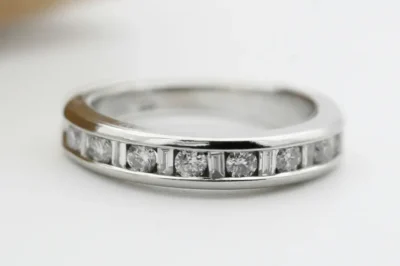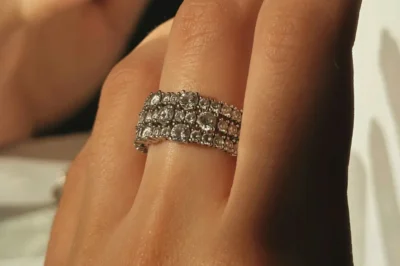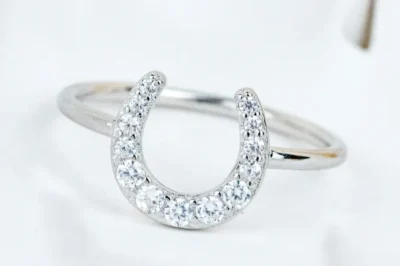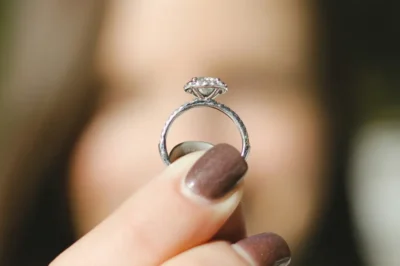TAKEAWAYS
18K gold and platinum are both premium ring setting metals with distinct characteristics. 18K gold contains 75% pure gold with 25% alloy metals, while platinum jewelry is typically 95% pure platinum.
Key differences include:
- Durability: Platinum is denser and stronger; 18K gold is more prone to scratches
- Color options: 18K gold offers yellow, white, and rose varieties; platinum is naturally white
- Weight: Platinum feels heavier and more substantial; 18K gold is lighter
- Maintenance: White gold requires rhodium re-plating; platinum develops natural patina
- Cost: Platinum is typically more expensive due to rarity and density
- Choose 18K gold for color variety, lighter weight, and affordability. Choose platinum for maximum durability, hypoallergenic properties, and timeless white brilliance that never fades.
Both metals are excellent for engagement rings—your choice depends on lifestyle, style preference, and budget considerations.
Choosing the perfect engagement ring or fine jewelry piece is one of life’s most exciting moments. You’ve probably spent hours browsing dazzling diamonds and sparkling gemstones, but here’s the truth: the ring setting metal is just as important as the stone itself.
Two of the most popular and timeless choices are 18K Gold and Platinum. Both are luxurious, beautiful, and widely used in fine jewelry. But when it comes to 18K Gold vs Platinum, which is the better choice for your lifestyle, taste, and budget?
This guide dives deep into everything you need to know about these two metals – their composition, durability, maintenance, cost, and style differences. By the end, you’ll feel confident about which one is the right fit for your dream ring.
Understanding Ring Setting Metals
Why the Metal Matters in Ring Design
Think of the ring setting metal as the “foundation” of your jewelry. It’s what holds your gemstone securely in place and frames its beauty. The metal you choose can:
-
Affect how your ring sparkles (a white metal like platinum can enhance the brilliance of diamonds, while yellow gold can create a warm glow).
-
Influence comfort and wearability (lighter vs heavier metals).
-
Determine how much maintenance you’ll need over the years.
-
Impact long-term value, since different metals have different levels of rarity and demand.
In short, the ring’s metal is not just background—it’s a starring role.
Overview of 18K Gold and Platinum in Jewelry
Both 18K Gold and Platinum have been used in fine jewelry for centuries. Gold has symbolized wealth and romance since ancient times, and platinum rose to prominence in the 20th century for its unmatched strength and prestige. Today, they remain the top two choices for engagement rings and luxury pieces.
But while they might look similar at first glance, these metals behave very differently.
What is 18K Gold?
Composition of 18K Gold
Pure gold is 24K, but it’s far too soft for daily wear. That’s where alloys come in. 18K Gold contains 75% pure gold and 25% alloy metals such as silver, copper, nickel, or palladium.
The alloys strengthen gold, making it durable enough for everyday rings. They also give it different shades:
-
Yellow gold: classic, warm, rich.
-
White gold: sleek, modern, requires rhodium plating.
-
Rose gold: romantic, blush-toned.
Advantages of 18K Gold in Ring Settings
-
Luxurious feel: With 75% pure gold, 18K has a rich luster that screams elegance.
-
Color options: Unlike platinum, you get variety—yellow, white, or rose.
-
Easier to work with: Jewelers find 18K gold easier to resize or engrave.
-
Balance of durability and purity: Stronger than 22K gold, but still higher in purity than 14K.
Disadvantages of 18K Gold
-
Softer than platinum: Prone to scratches and bending with heavy wear.
-
White gold needs upkeep: The rhodium plating wears off, requiring re-plating every few years.
-
Potential allergies: Alloys like nickel may irritate sensitive skin.
What is Platinum?
Composition of Platinum Jewelry
Platinum used in jewelry is usually 95% pure platinum mixed with small amounts of iridium or ruthenium. That makes it more pure than 18K gold jewelry.
It’s naturally white, which means no plating is required.
Advantages of Platinum in Ring Settings
-
Extreme durability: Platinum is dense and can hold diamonds and gemstones more securely.
-
Hypoallergenic: Perfect for people with metal allergies.
-
Naturally white: Keeps its bright sheen without fading.
-
Prestige factor: Platinum is rarer than gold, which adds to its exclusivity.
Disadvantages of Platinum
-
Heavy weight: Some people love the feel of substance, while others find it bulky.
-
Patina development: Over time, platinum develops a matte finish known as patina. Some love this antique look, while others prefer regular polishing.
-
Higher cost: Platinum jewelry is often more expensive than gold because of its density and rarity.
18K Gold vs Platinum: Key Differences to Consider
Here’s where the real comparison happens.
Durability and Longevity
-
Platinum: Denser and stronger, making it ideal for everyday wear. Scratches don’t remove metal; they just shift it, meaning the ring retains its weight.
-
18K Gold: Durable, but scratches actually wear away metal over time. Less ideal for rough wear.
Color and Appearance
-
18K Gold: Offers variety—yellow, white, and rose. Perfect for personal style and unique looks.
-
Platinum: Always naturally white, which enhances the brilliance of diamonds.
Weight and Comfort
-
Platinum: Heavier, giving a substantial feel on the finger.
-
18K Gold: Lighter and more comfortable for those not used to heavy rings.
Maintenance Needs
-
18K Gold: White gold requires rhodium re-plating; all gold scratches more easily.
-
Platinum: Develops patina over time but can be polished back to a high shine.
Cost Comparison
-
Platinum: Usually more expensive due to rarity and density.
-
18K Gold: Luxurious but more affordable than platinum, offering a wider price range.
Lifestyle and Practical Considerations
Best Choice for Active Lifestyles
If you work with your hands or plan to wear your ring daily with little worry, platinum is the safer bet thanks to its strength.
Skin Sensitivity and Allergies
-
Platinum: Naturally hypoallergenic.
-
18K Gold: Usually safe, but alloys like nickel in white gold can cause irritation.
Resizing and Repairs
-
18K Gold: Easier for jewelers to resize or engrave.
-
Platinum: More difficult and requires specialized tools, making resizing pricier.
Which Metal is Best for Engagement Rings?
When to Choose 18K Gold
-
You want options like yellow, rose, or white gold.
-
You prefer a lighter ring.
-
You’re looking for luxury at a lower price than platinum.

When to Choose Platinum
-
You want a ring that can withstand heavy daily wear.
-
You love the naturally white color that never fades.
-
You have sensitive skin or allergies.
Side-by-Side Comparison Chart
| Feature | 18K Gold | Platinum |
|---|---|---|
| Composition | 75% gold + 25% alloys | 95% pure platinum |
| Durability | Strong, but scratches wear metal | Extremely durable, metal displaces |
| Color Options | Yellow, white, rose | Natural white only |
| Weight | Lighter, comfortable | Heavier, substantial feel |
| Maintenance | White gold needs re-plating | Develops patina, polish optional |
| Cost | More affordable | Typically more expensive |
| Skin Safety | May cause allergies (nickel) | Hypoallergenic |
| Resizing | Easier and cheaper | More difficult and costly |
Final Thoughts – 18K Gold vs Platinum for Your Ring
When it comes to 18K Gold vs Platinum, there’s no one-size-fits-all answer. Both are premium choices, but they shine in different ways:
-
Choose 18K Gold if you want color variety, a lighter feel, and a balance of luxury and affordability.
-
Choose Platinum if you prioritize durability, timeless white brilliance, and hypoallergenic properties.
At the end of the day, the best ring setting metal depends on your lifestyle, style preference, and budget. Whether you go for the warmth of gold or the strength of platinum, you’ll be choosing a metal that beautifully complements your diamond or gemstone and lasts a lifetime.






